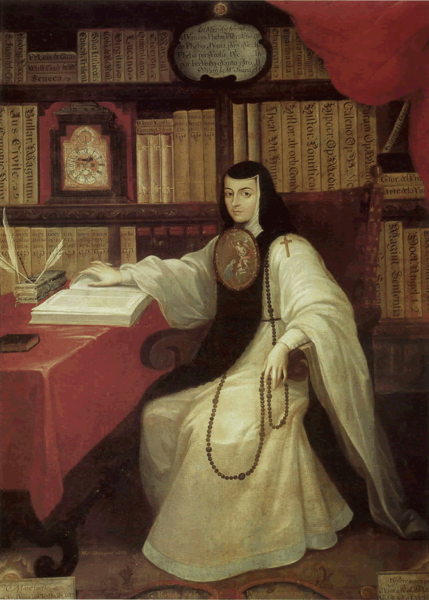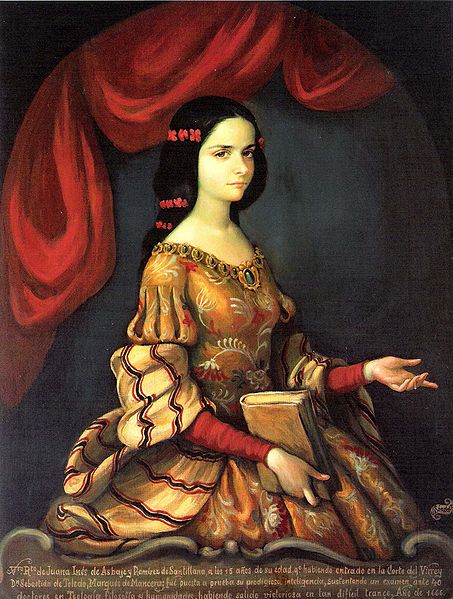<Back to Index>
- Botanist Anton Kerner von Marilaun, 1831
- Poet Juana Inés de Asbaje y Ramírez de Santillana, 1648
- General of the Ming Dynasty Qi Jiguang, 1528
PAGE SPONSOR


Sor (Sister) Juana Inés de la Cruz (12 November 1648/51 – 17 April 1695), fully Juana Inés de Asbaje y Ramírez de Santillana, was a self - taught scholar and poet of the Baroque school, and nun of New Spain. Although she lived in a colonial era when Mexico was part of the Spanish Empire, she is considered today a Mexican writer, and stands at the beginning of the history of Mexican literature in the Spanish language.
Juana Ines de la Cruz de Asbaje y Ramirez was born in San Miguel Nepantla, near Mexico City. She was the illegitimate child of a Spanish Captain, Pedro Manuel de Asbaje, and a Criollo woman, Isabe Ramirez. Her father, according to all accounts, was absent from her life. She was baptized December 2 and described on the Baptismal rolls as "a daughter of the Church." The future poet was raised in Amecameca, where her maternal grandfather owned an hacienda called Panoaya.
Juana was a devoutly religious child who hid in the hacienda chapel to read her grandfather's books from the adjoining library, something forbidden to girls. She learned how to read and write at the age of three. By age five, she could do accounts, and at age eight she composed a poem on the Eucharist. By adolescence, she had mastered Greek logic, and at age thirteen she was teaching Latin to young children. She also learned the Aztec language of Nahuatl, and wrote some short poems in that language.
In 1664, at age sixteen, Juana was sent to live in Mexico City. She asked her parents' permission to disguise herself as a male student so that she could enter the university. Not being allowed to do this, she continued her studies privately. She came under the tutelage of the Vicereine Leonor Carreto, wife of Viceroy Antonio Sebastián de Toledo. The viceroy (whom Appletons' Cyclopædia of American Biography names as the Marquis de Mancera), wishing to test her learning and intelligence (she being then seventeen years old), invited several theologians, jurists, philosophers, and poets to a meeting, during which she had to answer, unprepared, many questions, and explain several difficult points on various scientific and literary subjects. The manner in which she acquitted herself astonished all present, and greatly increased her reputation. Her literary accomplishments soon made her famous throughout New Spain.
She was much admired in the vice-royal court , and declined several proposals of marriage. In 1667, she entered the Convent of the Discalced Carmelites of St. Joseph as a postulant. In 1669, she entered the Convent of the Order of St. Jérôme. In
Juana's time, the convent was often seen as the only refuge in which a
female could properly attend to education of her mind, spirit, body and
soul. Nonetheless, she wrote literature centered on freedom. In her poem Redondillas she defends a woman's right to be respected as a human being. Therein, she also criticizes the sexism of the society of her time, poking fun at and revealing the hypocrisy of men who publicly condemn prostitutes,
yet privately pay women to perform on them what they have just said is
an abomination to God. Sor Juana asks the sharp question in this
age - old matter of the purity / whoredom split found in base male
mentality: "Who sins more, she who sins for pay? Or he who pays for
sin?" Sor Juana's “thinking out loud” was especially dangerous because the Counter Reformation was raging. Anyone who challenged societal values and ecclesiastical dogma could be investigated by the Spanish Inquisition on suspicion of heresy. Matters
came to a head in 1690, when a letter was published attacking Sor
Juana's focus on the sciences, and suggesting that she should devote
her time to soft theology. However, powerful representatives from the Viceregal Court and the Jesuit Order were her protectors and she was widely read in Spain, being called "the Tenth Muse". She was lauded as the first great poet of Latin America. Her work was also printed by the first printing press in New Spain. In response to her critics, Sor Juana wrote a letter entitled Respuesta a Sor Filotea (Reply to Sister Filotea), in which she defended women's right to education. In response, the Archbishop of Mexico joined other high - ranking officials in condemning Sor Juana's "waywardness". By 1693, Sor Juana seemingly ceased writing rather than risk official censure.
However, there is no undisputed evidence of her renouncing devotion to
letters, though there are documents showing her agreeing to undergo penance.
Her name is affixed to such a document in 1694, but given her deep
natural lyricism, the tone of these supposed hand - written penitentials
is rhetorical and autocratic Church formulae – one signed, "Yo, la peor de todas" (I, the worst / meanest of them all (the women)). She is said to have sold all her books, then an extensive library of over 4,000 volumes, and her musical and scientific instruments as well. Only a few writings have survived, which are known as the "Complete Works." According to Octavio Paz, Sor
Juana's writings were saved by the Viceroy's wife. In April 1695, after
ministering to the other sisters struck down by a rampant plague, she
is said to have died at four in the morning on April 17. An early translation of Sor Juana's work into English is Ten Sonnets from Sor Juana Inez de la Cruz, 1651 - 1695: Mexico's Tenth Muse, published in Taxco, Guerrero, in 1943. The translator was Elizabeth
Prall Anderson, Sherwood Anderson's third wife, who settled in Taxco
after her divorce from Sherwood. Arguably the most important book devoted to Sor Juana is by Octavio Paz. Paz's book, titled Sor Juana: Or, the Traps of Faith (tr. by Margaret Sayers Peden, 1989), is a work contemplating Sor Juana's poetry and life in the context of the history of New Spain,
particularly focusing on the difficulties women then faced while trying
to thrive in academic and artistic fields. Octavio
Paz describes how he had been drawn to her work by the enigmas of Sor
Juana's personality and life paths. Why did she become a nun? How could
she renounce her lifelong passion for writing and learning? Paz knew
that such questions could be answered only in the context of the world
in which she lived, and so he begins his study with a portrayal of the
cultural, political, and ideological forces of New Spain, wherein the subjugation of women was absolute. In his book, Paz makes a thorough analysis of Sor Juana's poetry and traces some of her influences to the Spanish writers of the Golden Age and the Hermetic tradition, mainly derived from the works of Athanasius Kircher. Paz analyses Sor Juana's most ambitious and extensive poem, "First Dream" (Primero Sueño) as largely a representation of the desire of knowledge through a number of hermetic symbols,
albeit transformed in her own language and skilled image - making
abilities. In conclusion, Paz makes the case that Sor Juana's oeuvre
was the most important body of poetic work produced in the Americas
until the arrival of XIXth century figures such as Emily Dickinson and Walt Whitman. Just
as Paz illuminates Sor Juana's life by placing it in its historical
setting, he situates her work in relation to the traditions that
nurtured it. Paz singled out the qualities that distinguish her work
and mark her uniqueness as a poet. For Octavio Paz, Sor Juana's
writings, like her life, epitomize the struggle of the individual, and
in particular the individual woman, for creative fulfillment and
self - expression, for integration of soul, spirit, and mind, not just as
a contemplative, but in real ways in the real world.